WATKINS GLEN, Apr. 12, 2024 — For 14 years, the state Department of Environmental Conservation stood firmly on the need to enforce a rule requiring reclamation of mined-out land under any permit to allow the Padua Ridge gravel mine to expand.
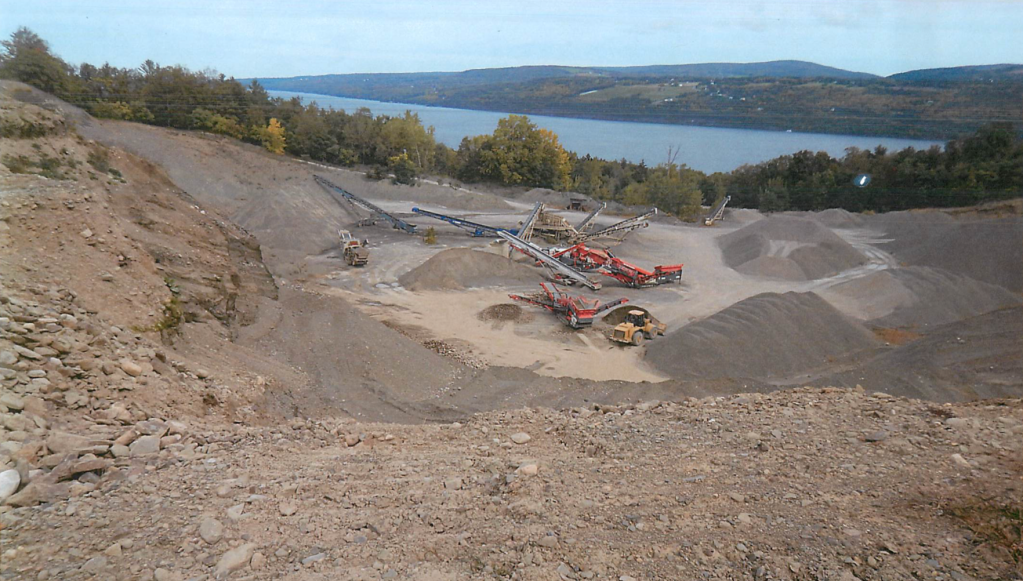
But in July 2022, the agency revealed its willingness to wobble.
That’s when a DEC official pronounced as “adequate for public review” a proposed blueprint to quintuple the size of the mine even though the plan included a new reclamation loophole.
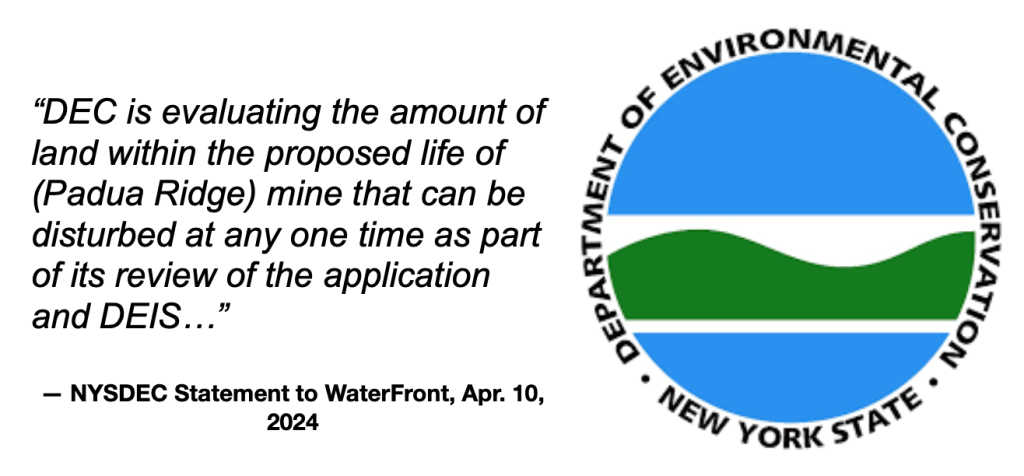
Today, the mine’s owner, Martin Wojcik, seeks a DEC permit to expand the mine from 14.33 acres to 75.28 acres while preserving that loophole.
The longstanding DEC rule said mining must be limited to 15 acres at one time. Mining into new areas could only come after reclamation of acreage of an equal size. Wojcik’s 2022 blueprint and his current application replaced the 15-acre rule with new language: “… (P)ortions of the active mine area will be reclaimed as work progresses so that the area of disturbance never exceeds 50 acres.”
Changing the limit for active mining from 15 acres to 50 acres would provide Wojcik carte blanche to delay or skip reclamation for many years.
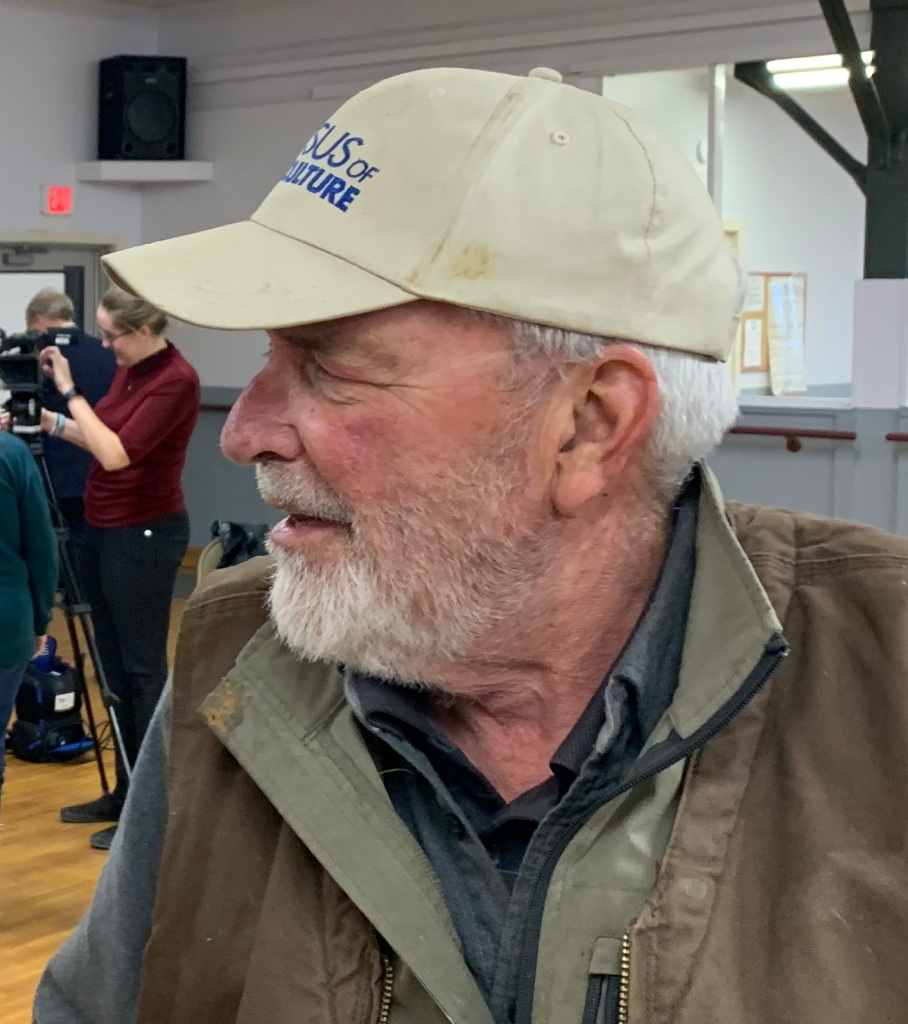
Reclaiming land that has been completely mined — by regrading slopes, applying topsoil and establishing vegetation — would be costly for Wojcik’s company, It’s Greener Now Inc.(IGN).
Sidestepping reclamation would be costly for Watkins Glen, a tourism-dependent village at the bottom of a steep hill less than a mile from the mine.
Each new acre that is unreclaimed after mining would add to the mine’s vulnerability to erosion and lower its chances of containing stormwater in heavy rains. Recent photos show that overflows from the mine have carried sediment to a drainage ditch designed to protect Watkins Glen from flooding and impaired its usefulness.
Even discounting the gravel mine, flooding risks for Watkins Glen have been rated as “severe.” And those risks are rising due to climate change.
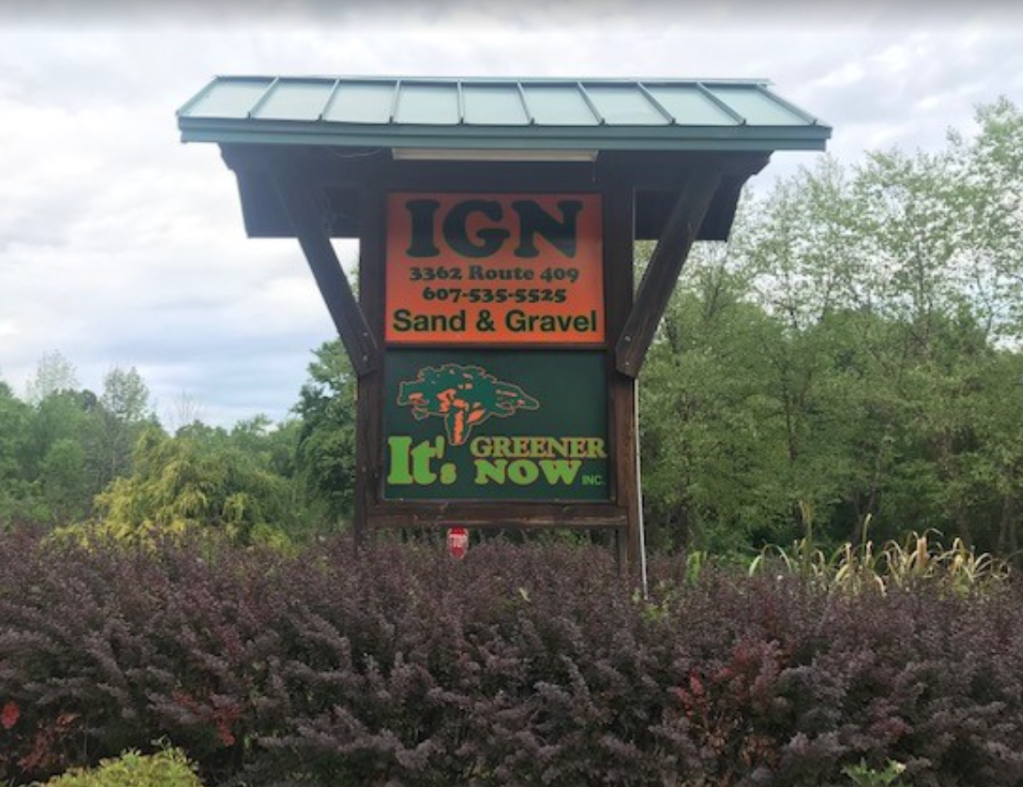
Each new unreclaimed acre also would widen the scar on the landscape.
“The extent of the disturbed area at the top of the ridgeline plays a significant role in whether the viewshed is picturesque and furthers the areas’ aesthetic that helps drive tourism or is a blight,” William F. Demarest III, an Albany attorney retained to oppose the mine expansion plan, wrote the DEC on April 5.
Demarest noted that tourists drawn to the gorge at the Watkins Glen State Park, the Seneca Lake Wine Trail and the Watkins Glen International Racetrack are the economic lifeblood of the region.
15-Acre Limit to Mining Established in 2008
The DEC established its 15-acre rule in a 2008 “final scoping outline” that applied to any expansion of the Padua Ridge mine. It said: “While the overall acreage of the mine will increase over the life of the project, the active mining excavation area, previously mined unreclaimed areas, and processing areas will not exceed 15 acres at any one time.”
That year Wojcik proposed to expand his 14.33-acre mine to more to 100 acres and build a new rail siding to ship gravel and sand by train. That scheme faced intense local opposition and soon fizzled.
More than a decade passed before Wojcik presented the DEC a more modest plan to expand the mine, this time without a rail siding.
But when the DEC’s Kristine Carlson reviewed his May 2019 draft environmental impact statement (DEIS), she found fault with its approach to reclamation.
“Please … confirm that active excavation area will be limited to 15 acres at any given time,” she wrote in a formal notice of incomplete application (NOIA).
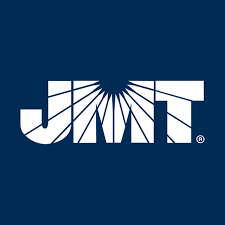
At first, a consultant for Wojcik agreed to follow Carlson’s insistence on reclaim-as-you-go mining.
“As stated in the final scoping outline, active mining excavation and processing areas will not exceed 15 acres at any one time,” Edward G. Davidson of JMT of New York Inc. wrote to Carlson on Sept. 24, 2021. And Wojcik’s rewrite of his DEIS that month included the 15-acre rule.
While Carlson acknowledged that he’d agreed to abide by the DEC’s reclamation rule, she required other revisions to the DEIS covering noise, stormwater controls and other issues, as detailed in a Nov. 24, 2021 NOIA letter.
The state Department Parks and Recreation had also noted deficiencies in Wojcik’s 2019 blueprint for expanding the mine. “We found no assessment of anticipated increases in noise, dust, vibration, truck traffic or other direct and indirect impacts that the expansion of this extractive (industry) would have on the historic (Watkins Glen State Park),” the an official in the department’s Historic Preservation Office wrote.
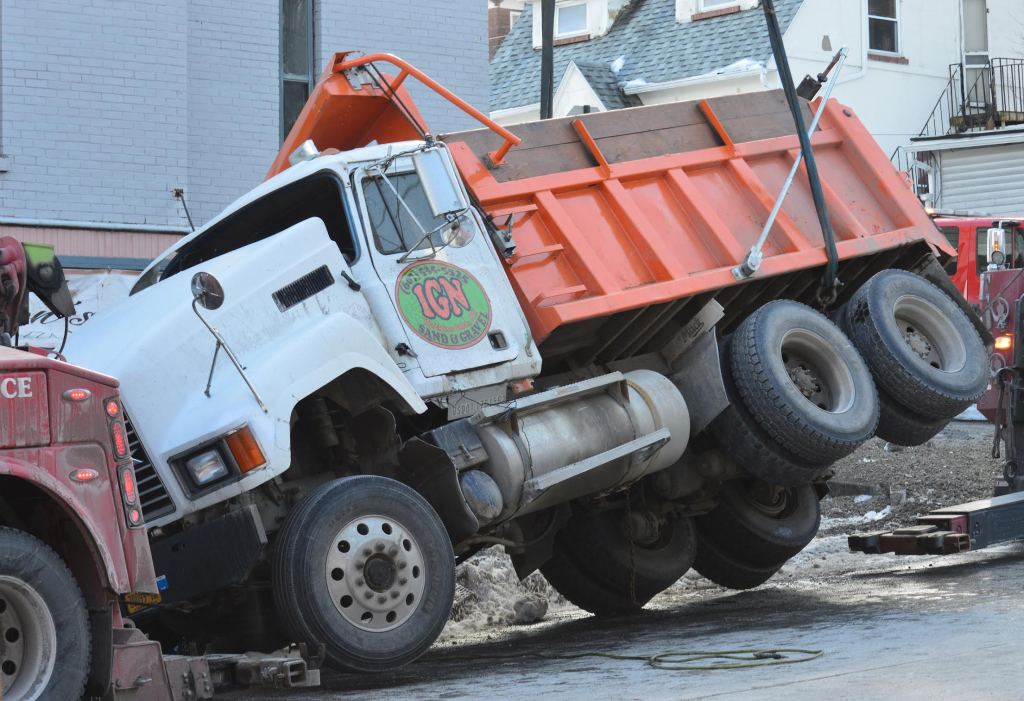
Wojcik’s consultant, JMT, justified the omission of analyses of dust, vibration and truck traffic by saying those “impacts are outside of the scope of the DEIS” because the 2008 final scoping outline didn’t call for them.
The Parks Department did not press its objections. Quite the opposite.
In a Dec. 10, 2021 letter to JMT, Historic Sites Restoration Coordinator Sloane Bullough gave Wojcik’s latest expansion proposal the green light, declaring that it would have “no adverse impact on historic resources.”
A Green Light From the Parks Department

Bullough did not specify why the Parks Department had dropped its objections even though there was still no analysis of truck traffic or vibration and only a cursory discussion of dust.
(The Parks Department has not provided any documents in response to WaterFront’s five-week-old request under the Freedom of Information Law (FOIL) for all department communications related to the Padua Ridge mine.)
After obtaining the Parks Department’s sign-off on Wojck’s updated DEIS, Davidson of JMT, changed his tune on reclamation.
In a June, 2022 letter to Carlson, he submitted a “drainage report,” which stated that reclamation would occur as mining progresses so that “the area of disturbance never exceeds 50 acres.”
If Carlson spotted the change from 15 acres to 50 acres and filed a formal response to Davidson, it was not included in the hundreds of documents DEC provided Waterfront in response to another FOIL request.
That summer Carlson, who had been the project manager for the Padua Ridge mine expansion application for three years, was reassigned — transferred from the DEC’s office in Avon to its office in Buffalo.
Carlson did not respond to an email from WaterFront requesting the date of and reason for her transfer. The DEC said in a statement to WaterFront that Carlson had requested the transfer “following a residency change.” The agency declined to provide the date of the transfer.
Wojcik learned that the staunch defender of the 15-acre reclamation rule was off his case in a June 29, 2022 letter he received from Thomas Haley, the regional permit administrator at the DEC’s office in Avon.
“As you may be aware,” Haley wrote, “the department’s assigned project manager, Kristine Carlson, has transferred to our Region 9 Buffalo office, so your application has been reassigned to me. Kris previously reported to me, so I am familiar with the project, but some additional time is needed to complete a thorough review.”
That review took less than two weeks.
“We have determined the content is adequate for public review,” Haley wrote to Davidson on July 11, 2022. “We are at the stage where it is necessary to review the DEIS and mining applications to incorporate any changes made since the last full submittal of the DEIS.”
That same day JMT submitted a revised 784-page DEIS that was not released to the public until January of this year. It contained no reference to the 2008 final scoping outline’s 15-acre rule, saying instead: “reclamation of mined areas will take place, to the greatest extent possible, concurrent with mining, to reduce the amount of land surface exposed at any given time.”
The DEIS also included the drainage report and the promise that “the area of disturbance never exceeds 50 acres.”
Public Comments Due Tomorrow
All mailed public comments on Wojcik’s DEIS must be postmarked by tomorrow, April 13. The DEC will accept emailed comments until 5 p.m. tomorrow.
(Comments can be sent to: Frances Knickmeyer, NYSDEC Region 8 Headquarters, 6274 E Avon-Lima Rd, Avon, 14414, or its-greener-now-comments@dec.ny.gov. More information is available here.
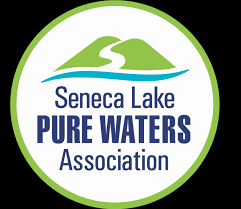
Seneca Lake Pure Waters Association submitted its comments in February. The non-profit environmental group made clear its objection to the document’s handling of reclamation. “Any site plan expansion should limit the amount of disturbed area to that which is in effect today (14.33 acres) as an enforceable permit condition,” SLPWA board member Ron Klinczar wrote.
And Demarest, the Albany attorney hired by Schuyler County legislator Michael Lausell, wrote the agency on Apr. 5: “The DEC should hold IGN to the 15-acre limit (first established in the 2008) final scoping document.”
The Schuyler County Legislature cited Demarest’s letter in a resolution adopted Monday night that restates its objection to Wojcik’s current application.

Demarest’s 13-page letter, which may be intended to serve as a legal warning to the DEC, catalogues a host of deficiencies in the DEIS. The partner in the firm Rupp Pfalzgraf LLC calls on the agency to require a supplemental environmental impact statement (SEIS) that corrects and expands on the current DEIS.
Alternatively, he writes, if the agency chooses to approve the application without an SEIS, it should impose strict rules on as-you-go reclamation, bar forever any mining north of State Route 409, and set a final closing date for the mine.
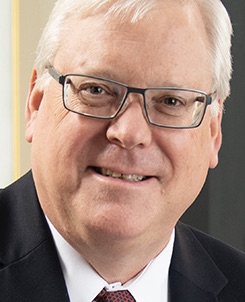
A week later, following Demarest’s lead, State Sen. Tom O’Mara (R-Big Flats) and Phil Palmesano (R-Corning) also called on the DEC to require a supplemental EIS.
Demarest dismissed as vague and unenforceable the DEIS’ assurance that reclamation would take place “to the greatest extent possible.”
In fact, Demarest wrote, the mine application states that while 12.49 acres are scheduled to be mined during a proposed upcoming five-year term, “acres to be reclaimed during the coming term are listed as 0 acres.”
Records show that Wojcik has been slow to respond to multiple DEC demands that he reclaim acres that were mined illegally.
A 2011 consent agreement between Wojcik and the DEC required IGN to reclaim 3.72 acres it had illegally mined outside its permitted 14.33-acre site.
Portions of that 3.72 acres — including land on the ridge that separates the mine from the St. Mary’s Cemetery and the Watkins Glen State Park — remain unreclaimed. If the DEC allows the 50-acre loophole, they may not have to be graded and seeded for decades to come.

A 2022 consent agreement between DEC and Padua Ridge LLC, a Wojcik company, required reclamation of several acres north of State Route 409 which had been excavated without a permit. The agency has twice extended the deadline for that reclamation, which is now due by June 15 of this year.
The DEC said this week that it hasn’t made a final decision on a reclamation rule applying to the gravel mine’s expansion. In an April 10 statement to WaterFront, the agency said: “DEC is evaluating the amount of land within the proposed life of mine that can be disturbed at any one time as part of its review of the application and (DEIS)…”
Reclamation Could Be Quite Expensive
Wojcik has a lot of money riding on the agency’s decision. Reclaiming mined land would require many thousands of tons more soil than the site currently has on hand. Buying hundreds of truckloads of soil and transporting it to the site could be quite expensive.
According to a November 17, 2022 email from JMT’s Davidson to the DEC, the site would require 7,630 cubic yards of material to reclaim 14.33 acres (the size of the currently permitted site) with four inches of soil.
“We estimate IGN currently has approximately 350 cubic yards of topsoil stockpiled within the life of the mine boundary,” Davidson wrote.
If a large dump truck can be assumed to carry about 14 cubic yards of dirt, the mine would need to import roughly 500 truckloads of soil to reclaim the entire 14.33 acres with four inches of soil.
Contacted by phone Thursday, Wojcik declined to comment.


Wow ! That was comprehensive .
LikeLike